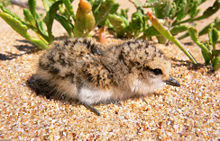- Red-capped Plover
-
Red-capped Plover 
Male in breeding plumage 
Female in breeding plumage Conservation status Scientific classification Kingdom: Animalia Phylum: Chordata Class: Aves Order: Charadriiformes Family: Charadriidae Genus: Charadrius Species: C. ruficapillus Binomial name Charadrius ruficapillus
Temminck, 1822The Red-capped Plover (Charadrius ruficapillus), also known as the Red-capped Dotterel, is a small plover. It breeds in Australia. The species is closely related to (and sometimes considered conspecific with) the Kentish Plover, Javan Plover and White-fronted Plover.
Contents
Description
Red-capped Plovers have white underparts and forehead. Their upperparts are mainly grey-brown. Adult males have a rufous crown and hindneck. Adult females have a paler rufous and grey brown crown and hindneck, with pale loral stripe. The upperwing of Charadrius ruficapillus shows dark brown remiges and primary coverts with a white wingbar in flight. Its length is 14-16 cm and its wingspan is 27-34 cm; weight 35-40 g. Breeding plumage shows a red-brown crown and nape with black margins. Non-breeding plumage is duller and lacks the black margins. [1]
Distribution and habitat
The Red-capped Plover is widespread in Australia; it is a vagrant to New Zealand, although it bred there for some time in small numbers from 1950-1980.[2] The species occupies a range of coastal and inland habitats, including estuaries, bays, beaches, sandflats and mudflats; inland saline wetlands. It is also found in inland wetland areas with bare ground.
Manly Marina, SE Queensland, Australia
Food
Mainly small invertebrates, especially molluscs, crustaceans and worms.
Breeding
 A chick, adopting a camouflaged position that helps it avoid detection by predators such as gulls and crows.
A chick, adopting a camouflaged position that helps it avoid detection by predators such as gulls and crows.
The Red-capped Plover is a seasonal breeder on the coasts of Australia, but breeds in response to unpredictable rains inland.[2] Nests on ground in vicinity of wetlands; nest a small depression with no or minimal lining. Clutch of 2 pale yellowish-brown eggs, irregularly spotted black. Incubation period 30 days; incubating mainly done by female. Young precocial and nidifugous.
Conservation
With a large range and no evidence of significant population decline, this species' conservation status is of Least Concern.
References
- ^ Grosset, Arthur. "Red-capped Plover Charadrius ruficapillus". http://www.arthurgrosset.com/ozbirds/red-cappedplover.html. Retrieved 9 January 2011.
- ^ a b Piersma, Theunis; Weirsma, Popko (1996), "Family Charadriidae (Plovers)", in del Hoyo, Josep; Elliott, Andrew; Sargatal, Jordi, Handbook of the Birds of the World. Volume 3, Hoatzin to Auks, Barcelona: Lynx Edicions, pp. 432–433, ISBN 84-87334-20-2
- BirdLife International. (2006). Species factsheet: Charadrius ruficapillus. Downloaded from http://www.birdlife.org on 12 February 2007
- Marchant, S.; Higgins, P.J.; & Davies, J.N. (eds). (1994). Handbook of Australian, New Zealand and Antarctic Birds. Volume 2: Raptors to Lapwings. Oxford University Press: Melbourne. ISBN 0-19-553069-1

This Charadriiformes-related article is a stub. You can help Wikipedia by expanding it.


